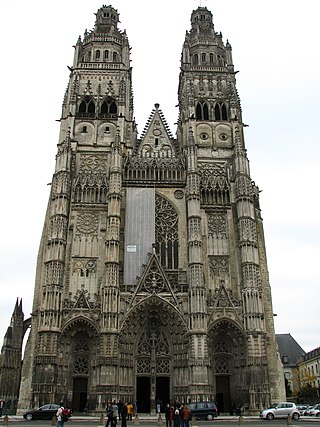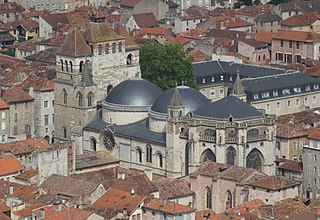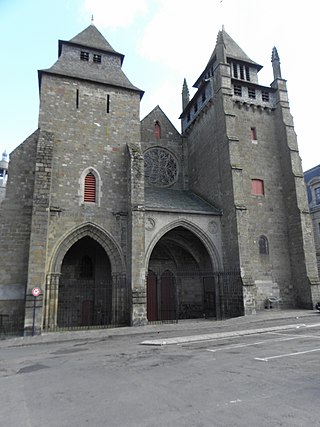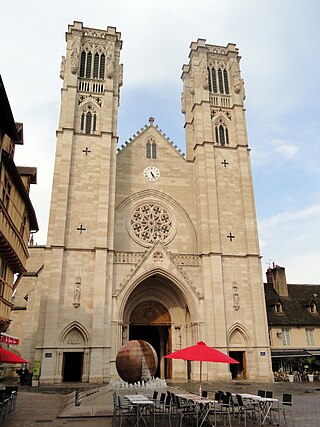History
The Chapter of the Cathedral of Apt was founded on 4 August 991 by Bishop Teudericus, in consultation with Prince Guillaume of Provence, Archbishop Annone of Arles, Archbishop Amalric of Aix, and Bishop Ingilram of Cavaillon, out of the clerics who served the cathedral. [1] The original charter establishes a corporation composed of a Provost and twelve canons. [2] By March 1247, dignities of the chapter are named in addition to the Provost: the Archdeacon, the Sacristan, the Precentor, and the Operarius. [3]
In 1790 the National Constituent Assembly conceived a plan to destroy the influence of the Estates throughout France and bring the whole country under central administration. This was to be done by the creation of some 83 or 84 'départements'. At the same time the Church was to be brought into subordination by abolishing the old ecclesiastical diocesan system and creating new dioceses which would have the same boundaries as the departments. The plan made more than fifty of the 135 Catholic dioceses in France redundant. The details were enacted by the Legislative Assembly, under the Civil Constitution of the Clergy (1790). [4] The diocese of Apt was one of the dioceses which were declared redundant and were suppressed. The abolition of Catholic dioceses was a violation of Canon Law, and the requirement that the clergy were to be obliged to take an oath to the Constitution in order to hold their jobs and collect their state-supplied salaries brought about a schism. New bishops and priests under the Constitutional system were to be elected by special 'Electors' in each department, who did not need to be Catholics or even Christians. That too was uncanonical and schismatic. The vows of monks and nuns were abolished by the National Assembly, and their property was seized by the State.
In 1801 First Consul Napoleon Bonaparte was preparing to end the religious confusion in France by entering into a Concordat with the Vatican. He had plans for the future, and he required a united France in order to carry them out successfully. In separate actions both he and Pius VII called on all bishops in France to submit their resignations. On November 29, 1801, by the bull Qui Christi Domini, Pope Pius VII suppressed all of the Roman Catholic dioceses in France, and immediately reinstituted them under papal authority. This act did away with whatever doubt or ambiguity might still exist as to a 'Constitutional Church' and 'Constitutional dioceses' in France. [5] Apt was not one of the dioceses that was restored.
The name of the diocese was revived, however, by Pope Benedict XVI in January 2009, as a titular see for bishops who have no diocese of their own.

The Archdiocese of Tours is a Latin Church archdiocese of the Catholic Church in France. The archdiocese has roots that go back to the 3rd century, while the formal erection of the diocese dates from the 5th century.

The Archdiocese of Bordeaux (–Bazas) is a Latin Church ecclesiastical territory or archdiocese of the Catholic Church in France. The episcopal see is Bordeaux, Aquitaine. It was established under the Concordat of 1802 by combining the ancient Diocese of Bordeaux with the greater part of the suppressed Diocese of Bazas. The Archdiocese of Bordeaux is a metropolitan see, with four suffragan dioceses in its ecclesiastical province: Dioceses of Agen, Aire and Dax, Bayonne, and Périgueux.

The Diocese of Gap and Embrun is a Latin Church ecclesiastical territory or diocese of the Catholic Church in Provence-Alpes-Côte d'Azur region of Southern France.

The Diocese of Fréjus–Toulon is a Latin diocese of the Catholic Church in southeastern France on the Mediterranean coast. The present diocese comprises the territory of the ancient Diocese of Fréjus as well as that of the ancient Diocese of Toulon. In 1957 it was renamed as the Diocese of Fréjus–Toulon.

The Archdiocese of Aix-en-Provence and Arles is a Latin Church ecclesiastical territory or archdiocese of the Catholic Church in France. The archepiscopal see is located in the city of Aix-en-Provence. The diocese comprises the department of Bouches-du-Rhône, in the Region of Provence-Alpes-Côte d'Azur. It is currently a suffragan of the Archdiocese of Marseilles and consequently the archbishop no longer wears the pallium.

The Diocese of Nice is a Latin diocese of the Catholic Church in France. The diocese comprises the Department of Alpes-Maritimes. The diocese is a suffragan of the Archdiocese of Marseille.

The former French Catholic Archbishopric of Arles had its episcopal seat in the city of Arles, in southern France. At the apex of the delta (Camargue) of the Rhone River, some 40 miles from the sea, Arles grew under Liburnian, Celtic, and Punic influences, until, in 46 B.C., a Roman military veteran colony was founded there by Tiberius Claudius Nero, under instructions from Julius Caesar. For centuries, the archbishops of Arles were regional leaders in creating and codifying canon law, through councils and synods.

The Diocese of Cahors is a Latin Church diocese of the Catholic Church in France. The diocese comprises the whole of the department of Lot.

The Archdiocese of Marseille is a Latin Church ecclesiastical jurisdiction or archdiocese of the Catholic Church in France. The archepiscopal see is in the city of Marseille, and the diocese comprises the arrondissement of Marseille, a subdivision of the department of Bouches-du-Rhône in the Region of Provence-Alpes-Côte d'Azur.

The former French Catholic diocese of Riez existed at least from fifth century Gaul to the French Revolution. Its see was at Riez, in the modern department of Alpes-de-Haute-Provence.

The former French Roman Catholic Diocese of Saint-Paul-Trois-Châteaux, sometimes, just like the town, also known as the Diocese of Saint-Paul-en-Tricastin, existed from the sixth century to the French Revolution.

The former French diocese of Sisteron existed until the French Revolution. Its see was at Sisteron in southern France and at Forcalquier, in the modern department of Alpes-de-Haute-Provence. Sisteron was the only diocese in France which had two cathedrals. Each cathedral had a Chapter, and the two Chapters voted together when an election was held to elect a new bishop of Sisteron. The diocese of Sisteron was part of the ecclesiastical province of Narbonensis Secunda, whose Metropolitan was the Archbishop of Aix-en-Provence.

The Archdiocese of Poitiers is a Latin archdiocese of the Catholic Church in France. The archepiscopal see is in the city of Poitiers. The Diocese of Poitiers includes the two Departments of Vienne and Deux-Sèvres. The Concordat of 1802 added to the see besides the ancient Diocese of Poitiers a part of the Diocese of La Rochelle and Saintes.

The Diocese of Bazas, centred on Bazas in Aquitaine, covered the Bazadais region, known under the Romans as the Vasatensis pagus after the ancient occupants, the Vasates. In the 2nd century it was part of the Novempopulania, one of the seventeen provinces of Gaul. The diocese must have been created between the first and the third centuries, but because of the large numbers of invaders that passed through this region - Arians, Saracens, Normans - the list of bishops is much reduced during the first millennium. The first bishop of this diocese is mentioned, without a name, by Gregory of Tours in his De gloria martyrum.

The Archdiocese of Auch-Condom-Lectoure-Lombez, more commonly known as the Archdiocese of Auch, is a Latin Church ecclesiastical territory or archdiocese of the Catholic Church in France. The archdiocese now comprises the department of Gers in south-west France. The archdiocese is a suffragan of the Archdiocese of Toulouse, and the current bishop, who therefore does not wear the pallium, is Maurice Marcel Gardès, appointed in 2004.

The Diocese of Saint-Brieuc and Tréguier is a Latin Church diocese of the Catholic Church in France. The diocese comprises the department of Côtes d'Armor in the Region of Brittany. The diocese is currently suffragan to the Archdiocese of Rennes, Dol, and Saint-Malo. The current bishop is Denis Moutel, appointed in 2010.

The Diocese of Nevers is a Latin Church diocese of the Catholic Church in France. The diocese comprises the department of Nièvre, in the Region of Bourgogne.

The former French Catholic diocese of Grasse was founded in the 4th or 5th century as the diocese of Antibes. It was originally suffragan to the Archbishop of Aix, and then to the Archbishop of Embrun. The see moved from Antibes to Grasse in 1244. It remained at Grasse Cathedral until the French Revolution. The diocese was suppressed by the Concordat of 1801, its territory passing to the diocese of Nice.

The former French Catholic diocese of Chalon-sur-Saône existed until the French Revolution. After the Concordat of 1801, it was suppressed, and its territory went to the diocese of Autun. Its see was Chalon Cathedral.



















